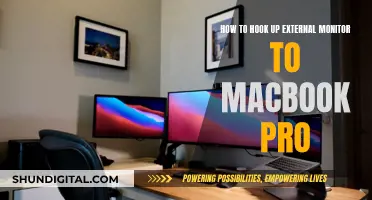Studio monitors should be set to a volume that is comfortable for the user and does not cause ear fatigue. While there are recommended decibel levels, these can vary depending on the size of the room, the type of music being produced, and the individual's hearing ability. It is important to be mindful of hearing health and safety when adjusting the volume of studio monitors.
| Characteristics | Values |
|---|---|
| Recommended decibel value | 75-85 dB |
| Volume level for a quick break | 86 dB |
| Volume level for a 30-minute break | 83 dB |
| Volume level for a 30-minute break after every 4 hours | 80 dB |
| Volume level for a 30-minute break after every 2 hours | 86 dB |
| Volume level for a comfortable conversation | Normal speaking volume |
| Volume level for a cinema | 83-85 dB |
| Volume level for a home studio | 73-76 dB |
| Volume level for streaming platforms | -14LUFS |
| Volume level for club music | -9LUFS |
What You'll Learn

Studio monitor volume and hearing health
Studio monitor volume is a critical aspect of the audio engineering process, impacting not only the quality of the mix but also the hearing health of the engineer. Prolonged exposure to loud noise can lead to permanent hearing damage, so it is essential to find the right balance between achieving the desired sound and protecting your hearing.
Recommended Volume Levels
The generally recommended volume level for studio monitors is between 75dB and 85dB. This range falls within the flat region of the Equal-Loudness contour, allowing for better judgment of the balance between low, mid, and high frequencies. However, it is important to note that sound pressure levels over 85dB can cause permanent hearing loss if exposure lasts for 8 hours or more. Therefore, it is crucial to be mindful of both the duration and intensity of exposure.
Subjectivity and Adaptability
While the recommended volume levels provide a guideline, it is essential to approach this topic with subjectivity. The appropriate volume may vary depending on the condition of your hearing and the style of music being produced. Some genres, such as bass-heavy Dub or Radio Pop, may require different volume levels to achieve the desired sound. Additionally, as we age, our hearing naturally deteriorates, and exposure to loud concerts or club nights can accelerate this process.
Low Volume Mixing
Mixing at lower volumes has its advantages. Firstly, it reduces the risk of hearing damage. Secondly, lower volumes result in less excitation of walls and objects in the room, reducing problems such as louder standing waves, more reverb, and unwanted vibrations. A simple trick to compensate for the change in mid-frequency perception at lower volumes is to use an equalizer to cut 3 to 6dB around 2kHz with a broad bandwidth.
Monitoring Levels for Home Studios
When calibrating your home studio monitors, it is essential to consider the size of the room. The recommended volume level of 85dB SPL was intended for larger spaces like cinemas. In most home studios, a target range of 73-76dB SPL is more appropriate. You can use a pink noise file and an SPL meter to calibrate your monitors to the ideal reference level for your studio size.
Protecting Your Hearing
To protect your hearing health, it is crucial to mix at lower volumes whenever possible and take frequent breaks during extended sessions. As a rule of thumb, keep the volume at a level where you can comfortably converse with someone nearby without raising your voice. Additionally, consider using headphones for critical listening tasks, as they allow for more precise control over volume and can reduce the impact of external noise on your mix.
Orangetheory Monitor: Worth the Investment?
You may want to see also

Recommended decibel levels
There are various recommendations for the ideal decibel level for studio monitors, with most sources suggesting a range of 70-85 dB. This range is considered optimal because, according to the Equal-Loudness Contour (an update of the Fletcher-Munson Curve), the perceived loudness in this range is very flat, enabling a better balance between low, mid, and high frequencies.
It's worth noting that the upper limit of this range (85 dB) can cause permanent hearing loss if one is exposed for 8 hours or more. Therefore, it is generally recommended to keep volumes below this level to protect your hearing, especially during extended mixing sessions. Some sources suggest that even 80 dB is too high and can damage hearing over years of exposure.
For untreated rooms, it is advised to restrict the frequency range of the noise to 500Hz-2kHz to minimize low-frequency standing waves or reflections. Additionally, an SPL meter with a C-weighted filter option is recommended for measuring the acoustic sound pressure level produced by your monitors.
The ideal volume also depends on the size of your studio space. For home studios, a range of 73-76 dB is more appropriate than the louder volumes intended for larger spaces like cinemas.
To find the right volume for your setup, you can use a pink noise file and adjust your monitors until the SPL meter reads the desired level. This process will help you calibrate your monitors to a loudness that works with your room size and the type of music you're creating.
As a quick reference, a good rule of thumb is to keep the volume at a level where you can comfortably talk to someone sitting next to you without raising your voice. This ensures that you're not exposing yourself to potentially harmful volumes over extended periods.
Finding Your Monitor's Refresh Rate: A Quick Guide
You may want to see also

Studio monitor volume and room size
Now, let's delve into the specifics of studio monitor volume. The ideal volume for studio monitors is between 70 dB and 85 dB. This range provides a flat response, allowing you to accurately judge the balance between low, mid, and high frequencies. However, it's important to consider hearing safety when adjusting the volume. Prolonged exposure to sound pressure levels above 85 dB can lead to permanent hearing loss. Therefore, it is recommended to mix at lower volumes, especially if you are working in a small or untreated room. Additionally, consider using a dB meter to measure the volume around your ear position to ensure it stays within a safe range.
Regarding room size, the dimensions of your room will influence the choice of studio monitor size. The physical size of the studio monitors and the distance between the drivers are important factors. Larger studio monitors are typically better suited for larger rooms as they require a greater distance from the listener to achieve a uniform sound. For smaller rooms, compact studio monitors with smaller woofers are often more appropriate. It's worth noting that the low-end frequency reproduction of your monitors will also be affected by the room size. If you have a small room, consider opting for studio monitors with a higher low-frequency cutoff, such as 60 Hz, to minimise the impact of room modes and improve midrange clarity.
To summarise, when selecting studio monitors and determining their volume, consider both the size of your room and the desired volume level. For smaller rooms, choose studio monitors with smaller woofers and adjust the volume accordingly to avoid excessive sound pressure levels. For larger rooms, you have more flexibility with monitor size, but it's still crucial to maintain safe volume levels to protect your hearing. Remember to treat your room acoustically to minimise sound issues and always give your ears regular breaks from prolonged exposure to loud volumes.
Monitoring Internet Bandwidth: Tracking User Activity
You may want to see also

Studio monitor volume and music genre
Studio monitor volume depends on the genre of music being produced. Some genres require a higher volume because the mid-frequencies are on different volumes. For example, a bass-heavy Dub track will sound quieter than a radio pop song with lead vocals or bright lead synths.
The recommended decibel value for studio monitors is between 75 dB and 85 dB. This is because, according to the Equal Loudness-contour, the perceived loudness is very flat in this area, allowing you to judge the balance between low, mid, and high frequencies.
It's important to note that sound pressure levels over 85 dB can cause permanent hearing loss if exposed for 8 hours or more. Studio monitors can produce this volume, so it's crucial to be mindful of your exposure time.
To find your personal "music production volume," it's recommended to keep the volume at a level where you don't need to talk louder than normal to someone standing a meter away. This is typically around 70 dB.
For different genres, you can adjust the volume accordingly. For rock and metal music, you can mix at louder volumes as the audience will likely listen at higher volumes. Conversely, for classical music, you can mix at lower volumes as the audience is less likely to blast the music.
Additionally, the size of the studio monitor driver depends on the room size and the music style. For instance, if you produce EDM, you'll need a better low-frequency response and a bigger driver size. On the other hand, smaller speakers may offer better midrange and high-frequency response due to their smaller size.
In conclusion, while there are recommended volume levels for studio monitors, the specific genre of music being produced can influence the optimal volume. It's important to be mindful of hearing health and make adjustments as needed to suit different genres.
Ankle Monitors: Alcohol Detection for Juveniles on Probation
You may want to see also

Studio monitor volume and speaker size
Studio Monitor Volume:
The ideal volume for studio monitors is generally considered to be around 80-85 dB. This range falls within the "flat" area of the Equal-Loudness contour, allowing for better judgment of the balance between low, mid, and high frequencies. Prolonged exposure to volumes above 85 dB can lead to permanent hearing loss, hence the importance of maintaining safe listening levels.
It is recommended to keep the volume at a level where you can comfortably converse with someone nearby without raising your voice. This is typically around 70-80 dB. However, it's crucial to use a sound level meter to accurately measure the decibel level at your listening position.
Speaker Size:
The size of studio monitor speakers, specifically the driver size, depends on factors such as room size and music style. For home studios, 5-inch speakers are often a good choice as they offer a balance between low and high-frequency response.
Larger drivers, such as 8-inch or 10-inch woofers, are better suited for music genres that require more low-frequency response, such as EDM. These larger speakers can move more air, reproducing lower-frequency sounds effectively.
On the other hand, smaller speakers with 4-inch or smaller drivers may offer improved midrange and high-frequency response due to their smaller size, making them more accurate in those ranges.
It's worth noting that speaker size isn't the only factor influencing sound quality. Other aspects, such as driver quality, amplifier power, and speaker placement, also play a significant role in achieving optimal sound.
Troubleshooting ASUS Monitor Driver Update Issues
You may want to see also
Frequently asked questions
There are various opinions on this topic, but the general consensus is that you should not exceed 85 dB to avoid hearing damage. Some sources suggest that the ideal volume is between 70 and 85 dB, while others recommend 73-76 dB for home studios.
You can use a sound level meter or an SPL meter to measure the volume. There are phone apps available that can measure this, or you can purchase a meter for around £15/$20 on Amazon.
Listening at volumes over 75 dB for prolonged periods can cause permanent hearing damage. It is important to take breaks and lower the volume to give your ears a rest.
When mixing at low volumes, you can compensate for the change in how the human ear perceives mid-frequencies by using an equaliser to cut 3 to 6 dB around 2 kHz. It is also important to take breaks and check your mix at different volumes to ensure the best results.







